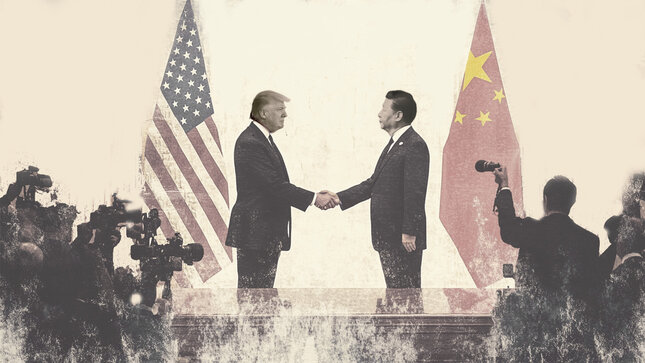- AUD/JPY is advancing as the Japanese Yen softens, driven by reduced demand for safe-haven assets.
- President Trump signaled a willingness to ease tariffs on Chinese goods, while Beijing has announced exemptions for selected US imports.
- The de-escalation in trade tensions is also lending support to the commodity-linked Australian Dollar.
AUD/JPY gains ground after registering more than 0.50% losses in the previous session, trading around 91.50 during the European hours on Tuesday. The pair is gaining as the Japanese Yen weakens, with demand for traditional safe-haven assets declining amid renewed optimism over US-China trade relations.
US President Donald Trump has signaled a willingness to reduce tariffs on Chinese goods, while Beijing has granted exemptions for certain US imports previously subject to its 125% levies. These developments have raised hopes for a resolution to the prolonged trade dispute between the world’s two largest economies.
Given the strong trade ties between Australia and China, easing US-China trade tensions may provide support to the commodity-linked Australian Dollar (AUD). Market focus is now shifting to Australia’s inflation report, due Wednesday, which could shape expectations for future Reserve Bank of Australia (RBA) policy moves. The RBA is widely anticipated to deliver a 25-basis-point rate cut in May as it braces for potential economic fallout from recent US tariffs.
Meanwhile, the Bank of Japan (BoJ) is set to announce its policy decision on Thursday, with expectations for rates to remain unchanged amid concerns over the fragile domestic economy. However, signs of expanding inflation could leave the door open for future tightening. A swift trade agreement between the US and Japan could further bolster the BoJ’s confidence to consider rate hikes, marking a sharp contrast with the growing belief that slowing global growth may push the Federal Reserve toward deeper rate cuts.
US-China Trade War FAQs
Generally speaking, a trade war is an economic conflict between two or more countries due to extreme protectionism on one end. It implies the creation of trade barriers, such as tariffs, which result in counter-barriers, escalating import costs, and hence the cost of living.
An economic conflict between the United States (US) and China began early in 2018, when President Donald Trump set trade barriers on China, claiming unfair commercial practices and intellectual property theft from the Asian giant. China took retaliatory action, imposing tariffs on multiple US goods, such as automobiles and soybeans. Tensions escalated until the two countries signed the US-China Phase One trade deal in January 2020. The agreement required structural reforms and other changes to China’s economic and trade regime and pretended to restore stability and trust between the two nations. However, the Coronavirus pandemic took the focus out of the conflict. Yet, it is worth mentioning that President Joe Biden, who took office after Trump, kept tariffs in place and even added some additional levies.
The return of Donald Trump to the White House as the 47th US President has sparked a fresh wave of tensions between the two countries. During the 2024 election campaign, Trump pledged to impose 60% tariffs on China once he returned to office, which he did on January 20, 2025. With Trump back, the US-China trade war is meant to resume where it was left, with tit-for-tat policies affecting the global economic landscape amid disruptions in global supply chains, resulting in a reduction in spending, particularly investment, and directly feeding into the Consumer Price Index inflation.
Information on these pages contains forward-looking statements that involve risks and uncertainties. Markets and instruments profiled on this page are for informational purposes only and should not in any way come across as a recommendation to buy or sell in these assets. You should do your own thorough research before making any investment decisions. FXStreet does not in any way guarantee that this information is free from mistakes, errors, or material misstatements. It also does not guarantee that this information is of a timely nature. Investing in Open Markets involves a great deal of risk, including the loss of all or a portion of your investment, as well as emotional distress. All risks, losses and costs associated with investing, including total loss of principal, are your responsibility. The views and opinions expressed in this article are those of the authors and do not necessarily reflect the official policy or position of FXStreet nor its advertisers. The author will not be held responsible for information that is found at the end of links posted on this page.
If not otherwise explicitly mentioned in the body of the article, at the time of writing, the author has no position in any stock mentioned in this article and no business relationship with any company mentioned. The author has not received compensation for writing this article, other than from FXStreet.
FXStreet and the author do not provide personalized recommendations. The author makes no representations as to the accuracy, completeness, or suitability of this information. FXStreet and the author will not be liable for any errors, omissions or any losses, injuries or damages arising from this information and its display or use. Errors and omissions excepted.
The author and FXStreet are not registered investment advisors and nothing in this article is intended to be investment advice.
Recommended content
Editors’ Picks

EUR/USD drops toward 1.1300 as US Dollar regains ground ahead of PCE
EUR/USD extends losses toward 1.1300 in the European session on Friday. The pair is undermined by renewed US Dollar demand as markets digest the recent US Courts' rulings on Trump's tariffs ahead of the German and US inflation data.

GBP/USD stays offered below 1.3500, awaits US PCE inflation data
GBP/USD snaps the previous day's goodish rebound and stays pressured below 1.3500 in European trading on Friday. A modest US Dollar uptick weighs on the pair, though the downside seems limited as traders might opt to wait for the release of the US PCE Price Index.

Gold price remains depressed below $3,300; lacks bearish conviction as focus remains on US PCE
Gold price maintains its offered tone heading into the European session on Friday and currently trades just below the $3,300 round figure. The intraday downtick is sponsored by a modest US Dollar strength, which tends to undermine demand for the commodity. However, a combination of factors assists the precious metal in holding above a one-week low touched on Thursday.

US core PCE inflation seen slightly lower in April, with Federal Reserve expected to cut rates in September
The U.S Bureau of Economic Analysis (BEA) is set to release the PCE Price Index data for April on Friday at 12:30 GMT. This index is the Fed's preferred measure of inflation. The core PCE Price Index is projected to rise 0.1% on a monthly basis in April after remaining unchanged in March.

Court cracks the tariff dam: Markets surf the euphoria wave
Just when traders thought they’d seen every twist in the tariff saga, the gavel dropped like a lightning bolt over the Pacific. In a blow to Trump’s tariff-centric economic blueprint, the U.S. Court of International Trade slammed the brakes on his sweeping global levies — ruling that the President had overreached.
